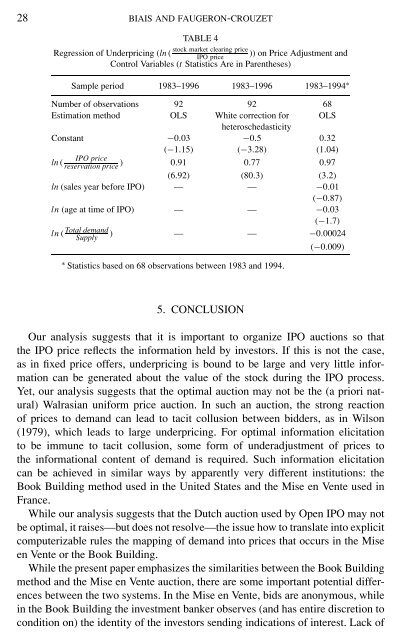IPO Auctions: English, Dutch, ... French, and Internet
IPO Auctions: English, Dutch, ... French, and Internet
IPO Auctions: English, Dutch, ... French, and Internet
Create successful ePaper yourself
Turn your PDF publications into a flip-book with our unique Google optimized e-Paper software.
28 BIAIS AND FAUGERON-CROUZET<br />
TABLE 4<br />
stock market clearing price<br />
Regression of Underpricing (ln ( <strong>IPO</strong> price )) on Price Adjustment <strong>and</strong><br />
Control Variables (t Statistics Are in Parentheses)<br />
Sample period 1983–1996 1983–1996 1983–1994 ∗<br />
Number of observations 92 92 68<br />
Estimation method OLS White correction for<br />
heteroschedasticity<br />
OLS<br />
Constant −0.03 −0.5 0.32<br />
(−1.15) (−3.28) (1.04)<br />
<strong>IPO</strong> price<br />
ln ( reservation price ) 0.91 0.77 0.97<br />
(6.92) (80.3) (3.2)<br />
ln (sales year before <strong>IPO</strong>) — — −0.01<br />
(−0.87)<br />
ln (age at time of <strong>IPO</strong>) — — −0.03<br />
(−1.7)<br />
ln (<br />
Total dem<strong>and</strong><br />
Supply<br />
) — — −0.00024<br />
(−0.009)<br />
∗ Statistics based on 68 observations between 1983 <strong>and</strong> 1994.<br />
5. CONCLUSION<br />
Our analysis suggests that it is important to organize <strong>IPO</strong> auctions so that<br />
the <strong>IPO</strong> price reflects the information held by investors. If this is not the case,<br />
as in fixed price offers, underpricing is bound to be large <strong>and</strong> very little information<br />
can be generated about the value of the stock during the <strong>IPO</strong> process.<br />
Yet, our analysis suggests that the optimal auction may not be the (a priori natural)<br />
Walrasian uniform price auction. In such an auction, the strong reaction<br />
of prices to dem<strong>and</strong> can lead to tacit collusion between bidders, as in Wilson<br />
(1979), which leads to large underpricing. For optimal information elicitation<br />
to be immune to tacit collusion, some form of underadjustment of prices to<br />
the informational content of dem<strong>and</strong> is required. Such information elicitation<br />
can be achieved in similar ways by apparently very different institutions: the<br />
Book Building method used in the United States <strong>and</strong> the Mise en Vente used in<br />
France.<br />
While our analysis suggests that the <strong>Dutch</strong> auction used by Open <strong>IPO</strong> may not<br />
be optimal, it raises—but does not resolve—the issue how to translate into explicit<br />
computerizable rules the mapping of dem<strong>and</strong> into prices that occurs in the Mise<br />
en Vente or the Book Building.<br />
While the present paper emphasizes the similarities between the Book Building<br />
method <strong>and</strong> the Mise en Vente auction, there are some important potential differences<br />
between the two systems. In the Mise en Vente, bids are anonymous, while<br />
in the Book Building the investment banker observes (<strong>and</strong> has entire discretion to<br />
condition on) the identity of the investors sending indications of interest. Lack of
















